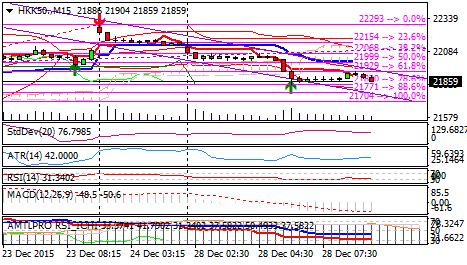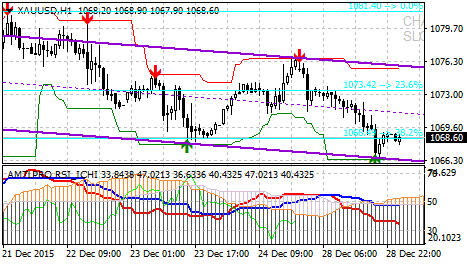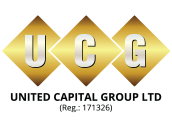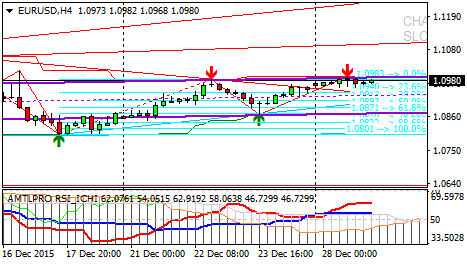Hang Seng Close Lower
The Hang Seng index in Hong Kong Stock Exchange closed down -218.51 points, or -0.99 percent, at 21,919.62. The weakening of the Hang Seng Index with investors look at the data of economic indicators are expected to weaken yesterday afternoon.
November Trade Balance Data of Hong Kong will be released after hours trading is closed, expected to be in a position H $ -30.5 billion, down from the previous H $ -29.6 billion.
Similarly, the decline in crude oil prices in the Asian session, to put pressure on oil stocks on the Hong Kong stock exchange. In the Asian trading session, the price of WTI crude oil was observed traded at 37.91 dollars per barrel, down 19 cents. Brent prices fell 18 cents to 37.71 dollars per barrel.
At the close of trading yesterday afternoon, shares of China Petroleum & Chemical Corp. closed down -3.43%, shares of China Shenhua Energy Co Ltd fell -2.08%, shares of PetroChina Co Ltd fell -2.04%.
While the Hang Seng index futures movement observed a weakening -244 points or -1.10% at 21,899.00, up from the previous closing at 22,143.00.
Technically, the index on the trading session today, Tuesday (29/12) likely to weaken, test negative trends, the impact of Wall Street. At the M15 chart bearish engulfing formation provides opportunities for the index to move downside. However, the volume tends to increase, an early indication of bullish index. In addition, RSI, the M15 chart, was oversold, signaling upside.
It is estimated, the index test the first support level 21800 and 21710. If it fails at 21 870, then the next index is expected to tend to retest the resistance level that is 21 920 and continued until the possibilities are in the area 21 980.

Euro Jumped Up
After clinch a weekly gain last week, the euro continued to strengthen in the beginning of the last trading week of 2015. The currency of 19 countries is also likely to record the best monthly performance since April, although this month the European Central Bank (ECB) to extend the quantitative easing program (QE ), while the US Federal Reserve raised interest rates for the first time since 2006.
Comments member of the executive board of the ECB, Yves Mersch who impressed dovish ignored by market participants. Citing Bloomberg report, Mersch, a member of the executive board of the ECB, said policymakers use all the ammunition.
Since the ECB QE prolonged for six months until March 2017, as well as lowering the deposit rate to -0.3% on the 3rd of December, the euro has gained about 3.4% against the dollar. President of the ECB, Mario Draghi, at the beginning of this month emphasized the exchange rate is not a target of monetary policy, while also acknowledging the value of the exchange rate “essential” to price stability and growth.
Technically, today’s trading session on Tuesday (29/12), the pair Euro-dollar likely to move in a positive trend.
The strengthening Euro is mainly expected to immediately re-examine the minimal resistance at 1.1030 and maximum 1.1100. Meanwhile, if the Euro unable to break and stays below 1.0970 then the other alternative scenario that Euro likely to test support in 1.0925 area and 1.0875.
Gold Price Drops
Gold prices fell at the close of trading on Tuesday before dawn (29/12) following the drop in oil prices, in thin liquidity in short days ahead of year-end holidays.
Spot gold prices fell 0.65 percent at 1,068.51 dollars per troy ounce, while US gold futures for February delivery fell $ 7.60, or 0.7 percent, at 1,068.30 dollars per troy ounce.
Gold rose nearly 1 percent during Christmas week, but down nearly 10 percent this year.
The price of gold reached its lowest since early 2010 this month in anticipation of rising US interest rates for the first time in almost a decade. Gold prices remained under pressure, waiting for more clues on monetary policy.
Oil prices fell 3 percent after a long Christmas weekend, pressing global equities lower. Gold was positively correlated with oil as the metal is seen as a hedge against oil-led inflation.
Demand for gold stalled in the centers of large gold purchases in Asia, dealers said, although the data showed China’s net gold imports from Hong Kong rose on a monthly basis in November as prices fell to lows throughout the year.
While the price of other metals, silver prices posted the biggest decline, down 3.3 percent at $ 13.87 per ounce. Platinum prices fell 0.9 percent to $ 873.25 per ounce, while the price of palladium was down 1.5 percent at $ 550 per ounce.
Technically, gold in today’s trading session Tuesday (29/12) potentially bearish, tested negative trend back, but prone to reversal. RSI indicator tends to re-test support channel and towards the oversold area, but Bollinger Band begins to widen, thus giving impetus for gold to the upside.
It is estimated that the gold price immediately prior to test support in the area of at least 1060.33 and re-test the maximum level of 1055.13. However, if the price of gold is able to break and hold above 1068.90, the predicted gold prices could potentially test Resistance ie, 1072.40 and 1077.72.








